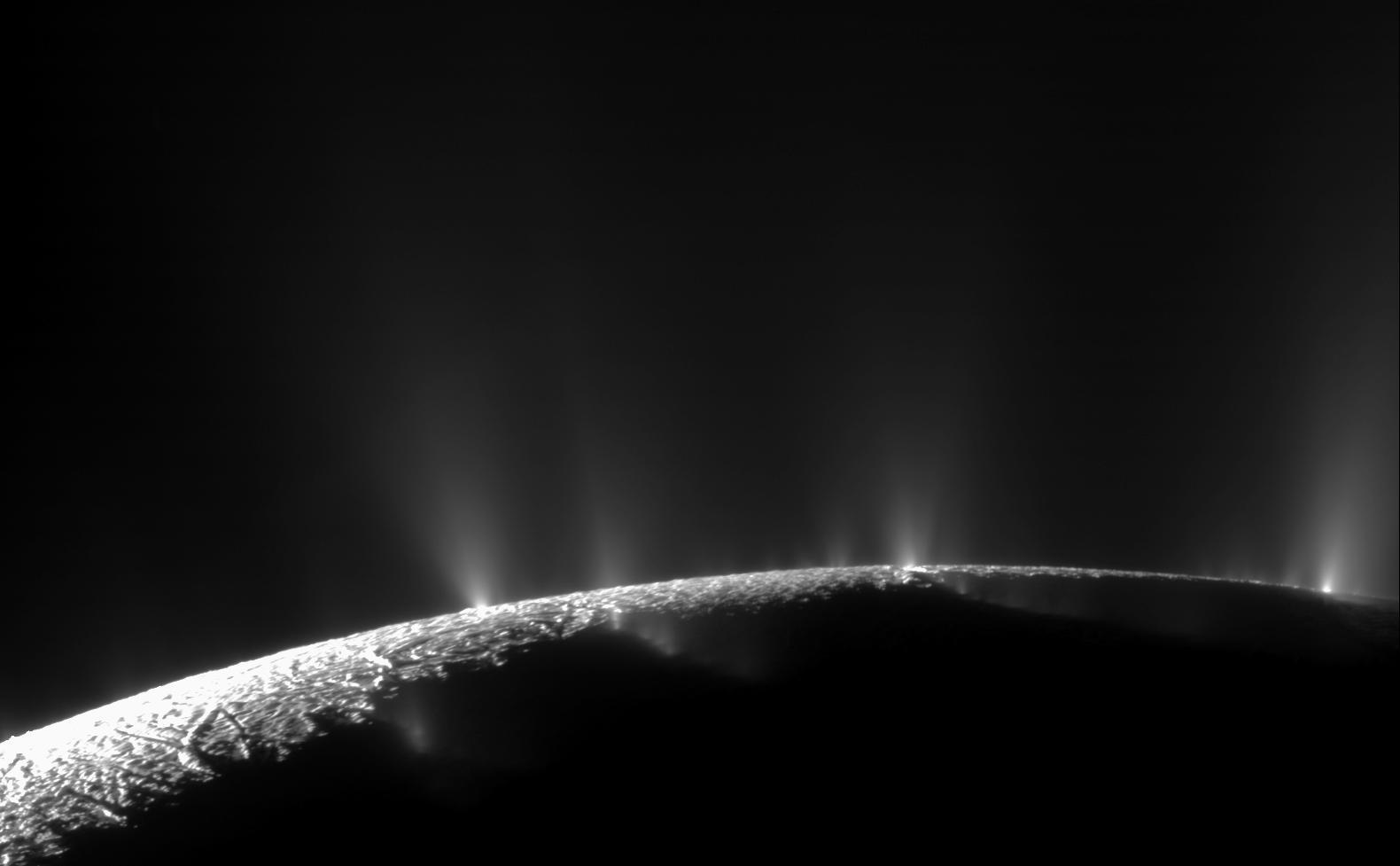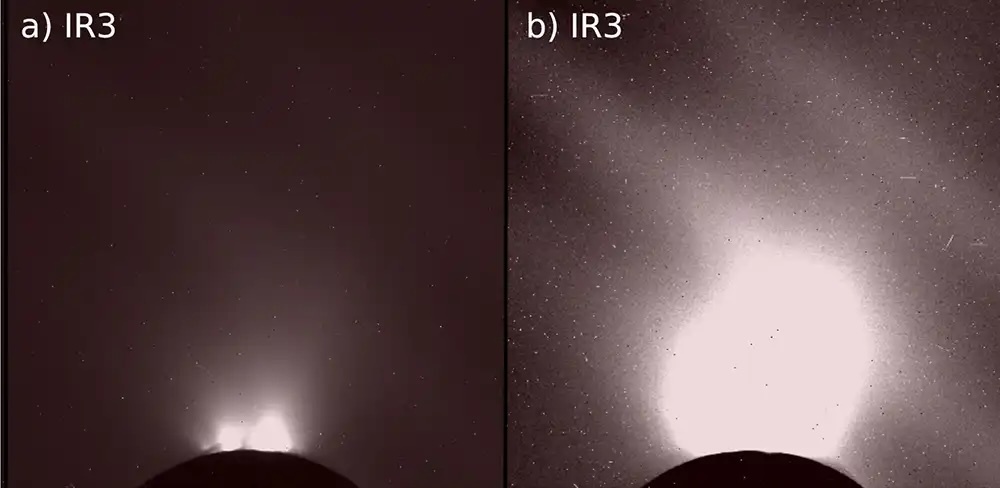19.08.2025
Scouring old data from NASA’s Cassini mission revealed puzzling atmospheric stripes that could help probe Saturn’s icy moon.

Cassini spies ice geysers erupting on Enceladus.
NASA / JPL / Space Science institute
About 1.2 billion kilometers from Earth lurks a potentially habitable world: Enceladus, the icy moon of Saturn, has a tantalizing liquid ocean beneath its surface. But life may not be the only Earthly feature this world harbors. Research published in Icarus earlier this summer reports an optical phenomenon in the plentiful particles spewed from geysers on the moon’s surface: space rainbows.
“This is a neat finding,” says planetary scientist Matthew Hedman (University of Idaho), who wasn’t involved with the study. It’s “an interesting set of observations they're trying to make sense of.”
The evidence for space rainbows lies in troves of data from NASA’s Cassini mission, an orbiter that explored Saturn and its moons from 2004 to 2017. Taking more than 635 gigabytes of data and 450,000 images, much of the information it gathered has yet to be sifted through.
The decision to dive into Cassini’s records began at a bar on the Delft University of Technology’s campus, when planetary scientist Stéphanie Cazaux and a colleague discussed how the Sun must be shining through Enceladus’ geysers much like it passes through raindrops after a storm on Earth. One of Cazaux’s students, Niels Rubbrecht, overheard and volunteered to find out.
Rubbrecht began by studying the optical conditions that create rainbows on Earth so he could build an image-processing tool to search for similar conditions in Cassini’s data. From a set of 40,000 images taken during flybys of the moon, he tracked the relative positions of the Sun, Enceladus, and the spacecraft to find bright spots that couldn’t solely be attributed to the Sun’s background light. Indeed, he detected parallel bright stripes in images from Cassini’s optical and infrared instruments. Finding the stripes in both cameras indicates that the features aren’t imaging artifacts.
“With this sort of weird-looking thing in cameras, the easiest explanation is always to say, ‘Oh, it’s not something real,’” says Rubbrecht. But while “it might have been overlooked in the past, now puzzling it together, it really builds a strong case as to why it's not an image artifact.”
These parallel stripes come about due to sprays of icy particles from Enceladus’s 100-kilometer-tall geysers, say the researchers. These particles contribute to a ring around Saturn called the E Ring, with sections of particles arranged in a structured way that reflects sunlight in the observed stripey pattern.

This archival image from the Cassini spacecraft shows stripes created from a rainbow-like phenomenon. The two images show the same stripes but with two different linear stretches of the data.
Rubbrecht et al. / Icarus 2025
But working backwards from the stripes to the particles may in fact be the more interesting exercise, the researchers think, since it could reveal more about the identity of the material that’s being ejected from Enceladus’ ocean, such as whether it’s ice or vapor, and what shape and crystal structure the particles have.
For now, the particles are a mystery, says Cazaux. “We just know that there is something making these big rainbows, but we don't know . . . why it's there, and if it's coming from these ‘alien snowflakes.’”
Enceladus’s rainbows aren’t the only optical phenomenon scientists have spotted in space. Tiny ice crystals in the Martian atmosphere enabled the Perseverance rover to photograph the Sun ringed in a “halo” created as the particles diffracted the sunlight. And thick clouds 70 kilometers above Venus enabled the European Space Agency’s Venus Express probe to spot colorful concentric rings known as a “glory,” a visual effect only possible when the observer is situated between the Sun and reflective clouds. Both phenomena, which also occur on Earth, enabled scientists to learn more about the particles in the atmospheres of those distant worlds.
While Hedman is intrigued by the team’s results and encouraged by its appearance across multiple instruments on the spacecraft, he thinks the rainbow’s location in front of Enceladus, rather than closer to Saturn, is “counterintuitive.” Since the particles behind the moon are far more numerous than those in front of it, he says he is “still skeptical.” However, he thinks it’s quite plausible that other planetary scientists like him have missed the phenomenon, since they’re normally focused on Enceladus’s bright plumes rather than the spots assumed to be camera artifacts.
Next, Rubbrecht hopes to use JWST data to constrain and subtract background levels of light from their images. He also hopes to make theoretical models of matter that could create such weird stripes.
If the rainbows do turn out to be real, Hedman thinks they could have implications beyond Saturn. “The fact we haven't noticed this before implies it requires special conditions,” he says. “What are those? And would those explain other potential phenomena in other astronomical contexts?” Either way, “It’s definitely worth figuring out what's going on.”
Quelle: Sky&Telescope
